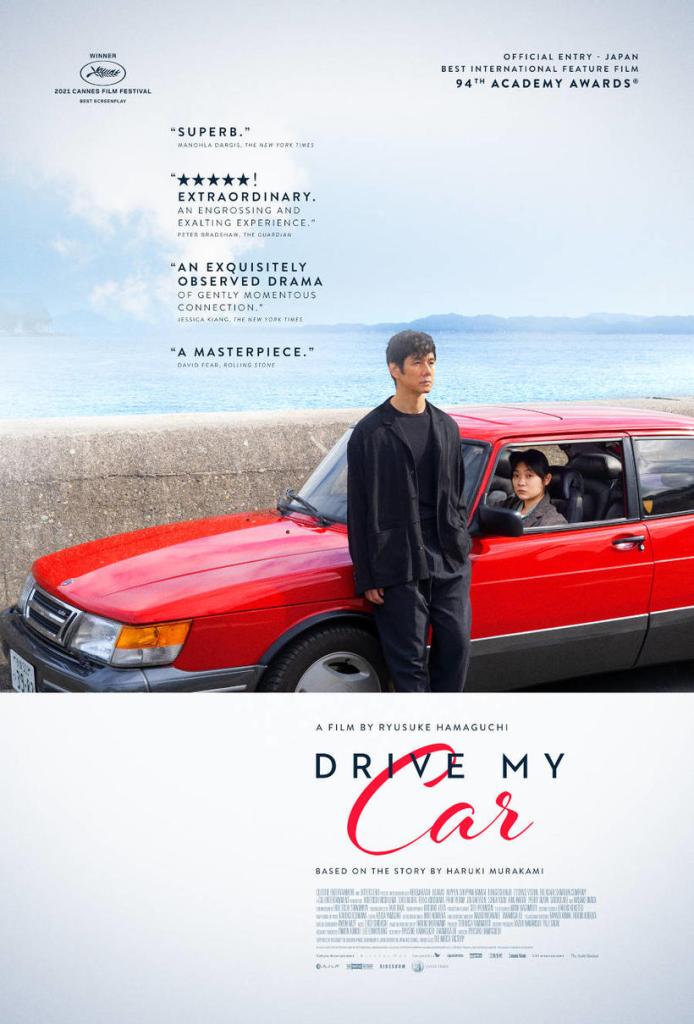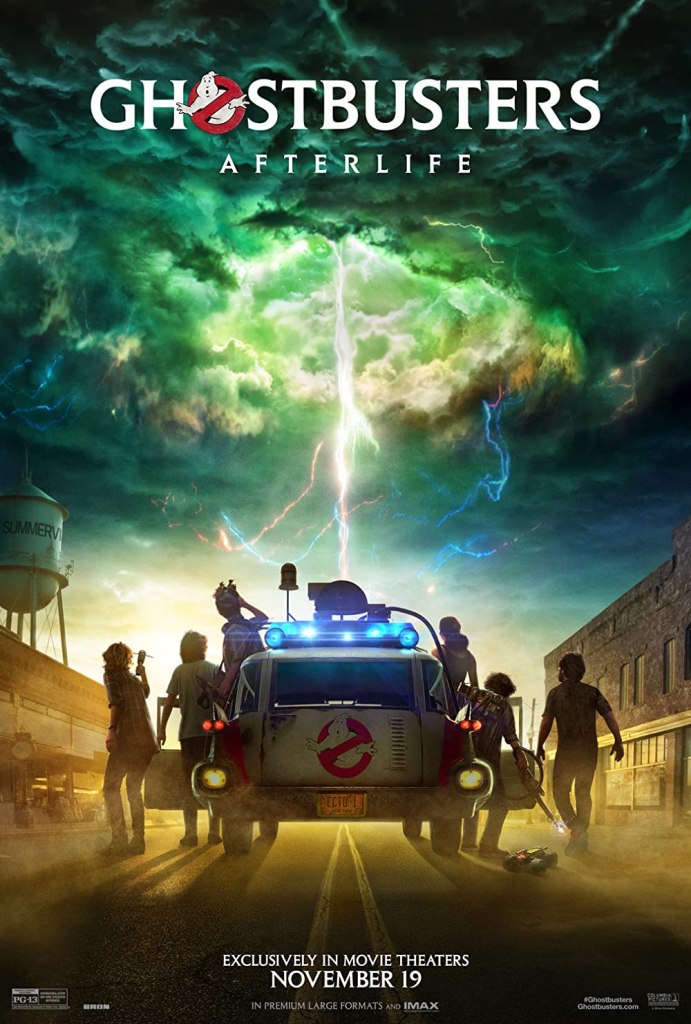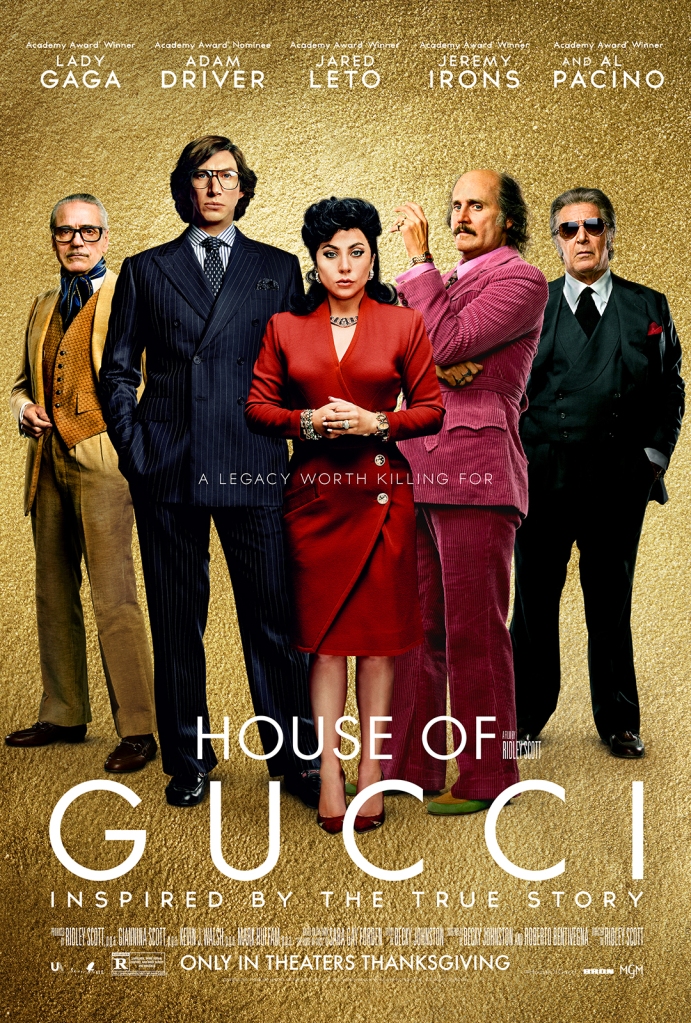Recently after exiting a local movie theater I was scouring my wallet, looking past all the ticket stubs that have landed there in the last few months, and I realized there were a couple of films that I had seen- but not written about. So, here we are. Ironically, the film that reignited my need to write again was “Drive My Car”, a film I had to drive about forty-five minutes to get to as the showings in my area were slim to none. Since that one was so powerful in its storytelling, it made the other lackluster films more palatable to write about as a group piece than stand alone reviews. In my defense the other two films aren’t exactly Bad per se, it’s just that I initially didn’t feel compelled enough to immediately write about them.

Drive My Car
Written by Takamasa Oe and Ryûsuke Hamaguchi and directed by Hamaguchi, “Drive My Car” is a long form drama adapted from a series of short stories by Haruki Murakami. Some audiences may groan about films with invariably long runtimes (This one is about an even three hours), anything over two and a half hours usually gets this treatment, but especially if it’s a slow-burn. However, this film is a near perfect example of the depth of characterization that can be achieved through long form dramas. Throughout this film I was having flashbacks of Yasujiro Ozu’s great films. While most of Ozu’s films never got longer than little over two hours, with the occasionally rare film nearing two hours and forty minutes, “Drive My Car” feels poised to maximize all of it’s emotional weight through devastating reveals late in the game with characters directly telling stories to others. Ozu’s films had similar levels of emotional intelligence and weight to them, but here, in today’s world, it feels as though the filmmakers had to cut through all of our modern societal expectations to get to the core of the story. So, what is the story actually about? It’s mainly concerned with Yûsuke Kafuku (Hidetoshi Nishijima) an actor/director in theatre who accepts a two month residency in Hiroshima as he presides over the production of Anton Chekhov’s “Uncle Vanya”- and Misaki Watari (Tôko Miura) his assigned driver during that residency. There are a LOT of small beautiful moments set against broader and more meaningful evolutions, but I don’t think I’ve ever seen a film so invested in language, silence, communication between people, and the theatre done in such a moving way. I really don’t want to dive too far into the details of the story, but patience will be rewarded if you’re paying attention. This one is incredible, and I highly recommend it.

Ghostbusters: Afterlife
Written by Gil Kenan and Jason Reitman, and directed by Reitman (son of director Ivan Reitman), “Ghostbusters: Afterlife” is a mostly genial nostalgia-fest that has it’s fair share of hits and misses throughout the runtime. First, and foremost, I did mostly enjoy my time with this movie, so please take these criticisms with the knowledge that I’m not just some dude in a basement raging about The Ghostbusters with undue spite. In fact, the first half of the movie feels more like an indie drama on the film fest circuit than it does a sequel to one of the biggest blockbuster franchises from the 1980’s. The story follows the adult daughter of Egon Spengler (Harold Ramis), Callie (Carrie Coon), who moves out to the farm that Egon left her after his untimely death with her two kids Phoebe (Mckenna Grace) and Trevor (Finn Wolfhard). While there the awkward teens encounter new friends, new secrets about their family’s past, and Trevor even gets to drive the Ecto-1 in a fun scene later in the film. Phoebe is the star of the film in every regard though. She’s the only one that feels related to Egon, she’s smart, horrible with jokes- which in itself turns into a joke, and she’s the scene stealer that every other actor should be on the lookout for. Seriously, that kid has a good future in acting if she sticks with it and continues to prove herself with more challenging roles. Finn Wolfhard on the other hand, he got the short end of the stick with the role of Trevor. This character essentially serves no narrative purpose, and he doesn’t actually do much of anything in the film either. That scene when he drives Ecto-1 around the small rural town with Phoebe firing off the Proton Pack- that’s the best scene in the film, and pretty much the only time Trevor gets to really be a part of the movie in any meaningful way. He’s here because his character, Mike, in “Stranger Things” wore a Ghostbusters costume on a Halloween episode. Which brings me to the second half of the film. Now, this is all leagues better than the 2016 “Ghostbusters” film in my opinion, but “Afterlife” feels hamstringed by the need to return to form after 2016- but in doing so it misses out on being it’s own film, it never truly innovates. It does try to do it’s own thing on occasion, but the third act goes overboard on the Nostalgia factor. Surprise, Gozer is back! Who ends up being caught by a bunch of ghost traps instead of anything different, because Hey, that’s a thing I know! There are also just plain inconsistencies with the older characters too. There’s a couple of moments that tried to paint Egon as someone “who just lost it“- with the eventual inclusion of Ray, Venkman, and Winston at the tail end of the film, Ray reveals that he’d had an argument with Egon and didn’t believe his warnings about the return of Gozer etc. That makes… zero sense. Why would Ray not believe Egon? Nothing in the other films suggests this as a logical evolution of either character. I must also take the moment to mention how awkward and creepy the ghostly re-animated Harold Ramis felt. It was too much. They could have had it all if they just kept his ghostly arm in that first shot where he helps Phoebe aim her proton pack- if they had just restrained themselves a bit, it would have been a more powerful scene. In the end, “Ghostbusters: Afterlife” fails to live up to the first two films, but does a decent enough job of returning the franchise back closer to home. Though there’s Paul Rudd, and that always makes the member-berries easier to forget. Moderately recommended.

House of Gucci
Written by Roberto Bentivegna and Becky Johnston, adapted from the book of the same name by Sara Gay Forden, and directed by Ridley Scott, “House of Gucci” follows the Gucci family through several decades of their decadent lives. Though I distinctively prefer “The Last Duel” as Ridley Scott’s best film of last year, this one certainly has it’s merits. As far as true life crime stories go, this one has the stars, the production value, and the score to best serve this Italian tale. Broadly, the film follows Patrizia Reggiani (Lady Gaga) as she enters the world of high dollar international fashion design through the infamous Gucci brand name. Gucci was one of the last major family owned businesses in Fashion, and Patrizia wanted in. The story also equally covers Maurizio Gucci’s (Adam Driver) rise to power within the family business which he begrudgingly accepts due to Patrizia’s insistence. The two patriarchs of the Gucci family are Aldo Gucci (Al Pacino) and Rodolfo Gucci (Jeremy Irons), Maurizio’s father. Aldo’s son Paolo Gucci (Jared Leto) also plays a part in the fashion game, though his inclusion comes in the second half of the film. The best part of this film are the performances with one glaring inconsistency. The four major players in the story portrayed by Lady Gaga, Adam Driver, Jeremy Irons, and Al Pacino are all fantastic and worthy of awards nominations- but not Jared Leto as Paolo Gucci. His entire performance is basically a joke (the truly magnificent prosthetic make-up made to transform Jared Leto into Paolo notwithstanding). His Italian stereotyping with his vocal choices is entirely bizarre and frankly I’m amazed Jeremy Irons didn’t slap Jared Leto in the face when acting those scenes with him on the principle of diluting the art of acting with nonsense like that. Though- admittedly, I laughed at Paolo and his ineptitude throughout the film. Frankly, I didn’t write about this one back when I saw it in theaters because I found the film to be… fine. Not entirely bad, but nothing spectacular either. It felt a little rote and a bit predictable. Though there is art on the screen, and the performances are worth seeing. Moderately recommended.